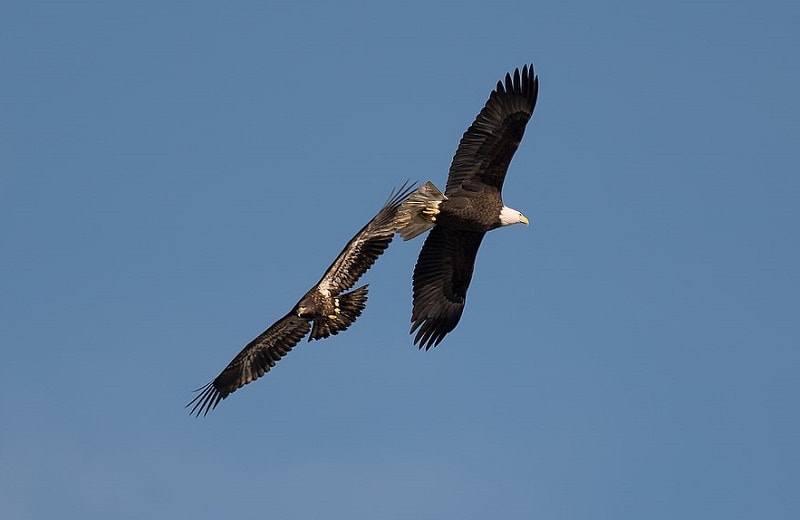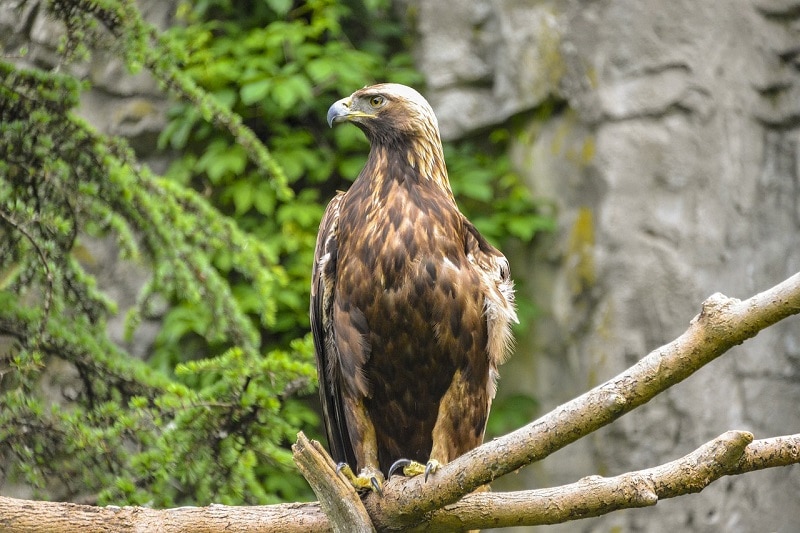2 Species of Eagles in Texas: Info, Pictures, History & Conservation
Last Updated on

Why are eagles so likeable? Well, it’s easy to fall in love with these birds of prey because they exhibit traits that are mostly associated with leadership. As a symbol, they represent grace, honor, bravery, determination, and more importantly, beauty. And here’s another crazy fact: Some religions believe that eagles can fly so high as to have “touched the face of God.”
Type of Eagles Found in Texas

Bald Eagle
You don’t have to be an avid bird watcher, or even an American, to know what a bald eagle looks like. This fierce creature has adorned the emblem of the United States since 1776. Its yellow beak, brown feathered body, and white head are all features that not only define it, but also make it stand out.
In the early 1950s, the wildlife conservation service realized that bald eagles were drastically reducing in numbers. At first, the cause was unknown, but after a lengthy investigation it was discovered that their avian immune system was being compromised by the dichloro-diphenyl-trichloroethane chemical—a synthetic insecticide developed in the 1940s to combat insect-borne human illnesses among the population.
For the sake of context this information is important, as it’s the reason why they almost went extinct.
Description
The bald eagles’ feet are yellow in color, and have sharp back talons. It’s one of those distinctive features that will quickly remind you why they’re regarded as predators in the ecosystem.

A juvenile bald eagle won’t look the same as a fledge eagle. In fact, if you’ve never seen one before, you’ll think you’re looking at a completely different species.
Before their wings and muscles sufficiently develop, they’re often brown in color, and have a few white markings under their chest and wings. But as they grow older, you start seeing colors that we’re all familiar with—the dark brown beak gradually turns to yellow, while the tail and head become white.
Regarding size, the female bald eagle will always be larger in comparison to its male counterpart, but they both share similar coloration. Typically, they all have a wingspan of about two meters, a weight of approximately 15 pounds, and on average, grow to about 0.9 meters.
Population Range
The bald eagle is not just found in the state of Texas, or exclusively in the United States. We’ve also had sightings in Canada, and in some parts of Mexico that are closer to the U.S. border.
Residents living close to the Mississippi River and in Alaska consider themselves privileged because they get to see bald eagles all year round. The rest of the country only gets to see them while they’re migrating or during winter.
The fact that bald eagles are always drawn to lakes is yet another interesting fact that you ought to take a note of. They love fish more than anything, and that’s why you’ll most likely find them soaring above lakes, or just perched on a tree nearby. That’s during summer though. During winter, they’ll hunt along rivers reservoirs, or surround unfrozen lakes.
There’s a reason why these birds are often labeled the opportunistic predators. Bald Eagles know how to survive in the wild, especially if the lake that they depend on as a source of food gets frozen. Taking advantage of their sharp talons and acute sense of sight, they’ll hunt snakes, muskrats, ducks, and even resort to feed on dead animals. Their method of attack is pretty simple; they’ll swoop down at an angel, catch it, and start pulling out the flesh.
Life History
Bald eagles are naturally monogamous. They’ll choose a partner, and stick by that partner for the rest of their lives. Of course, mating with a different partner is still a possibility, but only if the previous partner disappears or passes on. And by the way their courtship process is kind of hilarious, to be honest. It’s made up of a lot of aerial displays and numerous calls.

Like every other bird species, they have a way of building their nest. First off, the nest has to be next to a water body. It doesn’t matter if it’s fresh or salty. Secondly, the building blocks used in the construction process will be sticks. Not grass, leaves, or stones. And lastly, the nest has to be at least two feet deep, and five feet wide.
You’ll also be interested to know that a bald eagle’s nest is called an eyry, and it weighs about 900kg. They only lay a maximum of three eggs a year, and every mating pair takes turns incubating them. When one’s guarding and keeping the eggs warm, the other one’s out, busy looking for food or more sticks to fortify the nest. That becomes the routine for a little over a month, before the eaglets hatch.
Conservation and Protection Status
In 1967, the bald eagle was listed as endangered. This was after their numbers dwindled dramatically due to the DDT insecticide. It was then down listed to “threatened” in 1995, before being delisted in 2007.
But there’s still cause for alarm. You see, even though they’re now a species of least extinction concern, it would be a mistake to not acknowledge the fact that they still face different threats. One good example is the increase in the human population that has forced people to cut down trees along the shores, so as to build new homes. This practice has destroyed several nests, killed eaglets before they fully develop, and forced them to migrate.

Golden Eagle
Commonly referred to as the “King of Birds”, the golden eagle certainly tops the list of the toughest raptors on planet Earth. It’s incredibly fast, agile, and blessed with all features that you’d like to see in a predator often regarded as the “expert hunter”.

Golden Eagles prefer small mammals to fish. That’s why they’re always diving in pursuit of prairie dogs, hares, marmots, mice, and snakes, instead of spending time around lakes. Also, don’t be shocked when you see one of them preying on a mountain goat or a small deer. They sometimes like to hunt and kill animals that are way larger than them.
Description
The average size of a golden eagle’s wingspan is roughly 7 feet. But this is to be expected as we’ve seen them exhibit extraordinary soaring abilities. One would also argue that something that large won’t be able to clock a higher speed when pursuing a prey, but they actually do. Those who’ve witnessed and recorded them chasing after their prey have confirmed they move at 200 miles per hour on a good day.
A golden eagle’s eye structure is made up of cones, rods, and not one but two retinas. This right here tells you they can spot a prey more than two miles away.
Life History
Just like their compatriots, golden eagles are monogamous and love to guard their territories. They’ll mark territories as bigger as 60 square miles, even if the nests that they’ve built are close to the cliff.
Telephone poles are also common breeding grounds, and they often return to the same nests every time the females are ready to lay more eggs. And speaking of the females, they can only lay up to four eggs a year, and the incubation period is 45 days max. Just so you know, the mating pair also take turns incubating the eggs.
Population Range
This is not the only continent that the golden eagle calls home. They’re also common in Mexico, but not so common in Europe, Northern Africa, and Asia. Their migration will depend on several factors, including the geographic location. The ones found in the U.S. rarely migrate, but Canadian golden eagles have been known to migrate south during fall.

Conservation History and Status
In 1962, the Bald Eagle Protection Act was amended to include the golden eagles as well. This was more of a precautionary measure, seeing as their numbers also started going down. At first, conservationists thought the same chemical that affected the bald eagles was responsible for this until they realized golden eagles faced a different threat—Humans.
Due to an increase in the human population and industrialization, more power lines were being set up and this is what was killing these birds through electrocution. In 1970, utility companies started modifying their lines with the intent of decreasing the number of golden eagles being electrocuted yearly. Fortunately for us, golden eagles are no longer under the threat of extinction.

Differences between a Golden Eagle and a Bald Eagle
Differentiating a bald eagle from a golden eagle will be a daunting task, seeing as both of them have white patches all over their bodies and a brown head. However, as the bald eagle approaches maturity, it will start to develop a distinctive head and body coloring.
The other difference can be seen in their unique body features. The beak and the head of the golden eagle is a lot different from that of a bald eagle. It has a beak that is brown-ish black and a head small, while the bald eagle has a yellow beak and a slightly larger head.
Last but not least, we have to talk about how different their wingspans look when they’re in flight. That of the bald eagle will look like a straight line while that of the golden eagle somewhat makes a V-shape.

Conclusion
We hope you’ve learned something new about these raptors found in Texas. We would also like to hear from you, and maybe even share information on how we could all protect birds of prey. Feel free to reach out, should you have any question or suggestion.
If you liked this article, check out some of our other top-trending birding posts:
- 7 Common Yellow Birds in 2021: Pictures, Info, Nesting Behaviors & Protection Status
- 3 Proven Ways to Keep Sparrows Out of Bluebird Houses
- 7 Common Red Birds in 2021 (with Pictures)
- 10 Types of Ducks Found in Texas (With Pictures)
Featured Image Credit: Russ, Wikimedia Commons
About the Author Robert Sparks
Robert’s obsession with all things optical started early in life, when his optician father would bring home prototypes for Robert to play with. Nowadays, Robert is dedicated to helping others find the right optics for their needs. His hobbies include astronomy, astrophysics, and model building. Originally from Newark, NJ, he resides in Santa Fe, New Mexico, where the nighttime skies are filled with glittering stars.
Related Articles:
When Were Binoculars Invented? History, Today & Future
How to Clean a Refractor Telescope: Step-by-Step Guide
How to Clean a Telescope Eyepiece: Step-by-Step Guide
How to Clean a Rifle Scope: 8 Expert Tips
Monocular vs Telescope: Differences Explained (With Pictures)
What Is a Monocular Used For? 8 Common Functions
How to Clean a Telescope Mirror: 8 Expert Tips
Brightfield vs Phase Contrast Microscopy: The Differences Explained
